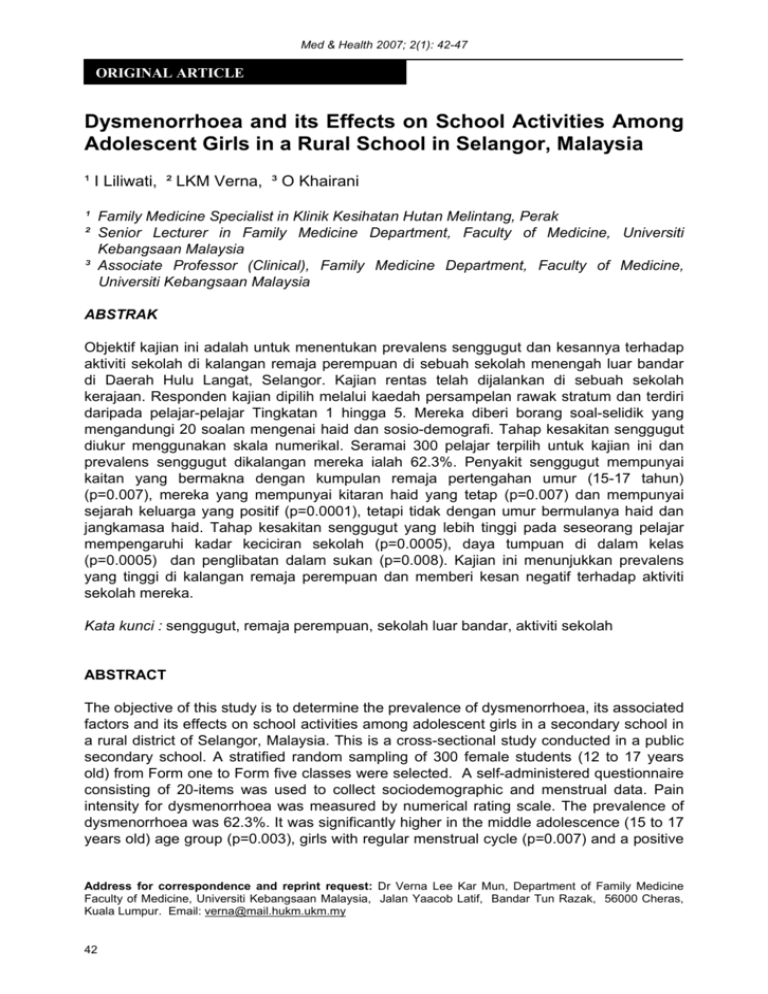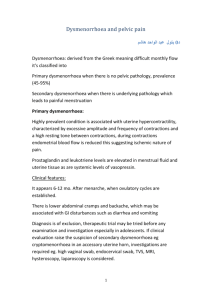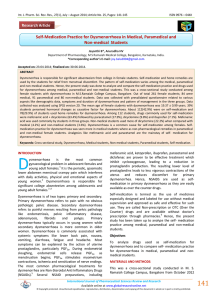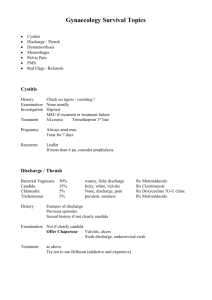Dysmenorrhoea and its Effects on School Activities Among
advertisement

Med & Health 2007; 2(1): 42-47 ORIGINAL ARTICLE Dysmenorrhoea and its Effects on School Activities Among Adolescent Girls in a Rural School in Selangor, Malaysia ¹ I Liliwati, ² LKM Verna, ³ O Khairani ¹ Family Medicine Specialist in Klinik Kesihatan Hutan Melintang, Perak ² Senior Lecturer in Family Medicine Department, Faculty of Medicine, Universiti Kebangsaan Malaysia ³ Associate Professor (Clinical), Family Medicine Department, Faculty of Medicine, Universiti Kebangsaan Malaysia ABSTRAK Objektif kajian ini adalah untuk menentukan prevalens senggugut dan kesannya terhadap aktiviti sekolah di kalangan remaja perempuan di sebuah sekolah menengah luar bandar di Daerah Hulu Langat, Selangor. Kajian rentas telah dijalankan di sebuah sekolah kerajaan. Responden kajian dipilih melalui kaedah persampelan rawak stratum dan terdiri daripada pelajar-pelajar Tingkatan 1 hingga 5. Mereka diberi borang soal-selidik yang mengandungi 20 soalan mengenai haid dan sosio-demografi. Tahap kesakitan senggugut diukur menggunakan skala numerikal. Seramai 300 pelajar terpilih untuk kajian ini dan prevalens senggugut dikalangan mereka ialah 62.3%. Penyakit senggugut mempunyai kaitan yang bermakna dengan kumpulan remaja pertengahan umur (15-17 tahun) (p=0.007), mereka yang mempunyai kitaran haid yang tetap (p=0.007) dan mempunyai sejarah keluarga yang positif (p=0.0001), tetapi tidak dengan umur bermulanya haid dan jangkamasa haid. Tahap kesakitan senggugut yang lebih tinggi pada seseorang pelajar mempengaruhi kadar keciciran sekolah (p=0.0005), daya tumpuan di dalam kelas (p=0.0005) dan penglibatan dalam sukan (p=0.008). Kajian ini menunjukkan prevalens yang tinggi di kalangan remaja perempuan dan memberi kesan negatif terhadap aktiviti sekolah mereka. Kata kunci : senggugut, remaja perempuan, sekolah luar bandar, aktiviti sekolah ABSTRACT The objective of this study is to determine the prevalence of dysmenorrhoea, its associated factors and its effects on school activities among adolescent girls in a secondary school in a rural district of Selangor, Malaysia. This is a cross-sectional study conducted in a public secondary school. A stratified random sampling of 300 female students (12 to 17 years old) from Form one to Form five classes were selected. A self-administered questionnaire consisting of 20-items was used to collect sociodemographic and menstrual data. Pain intensity for dysmenorrhoea was measured by numerical rating scale. The prevalence of dysmenorrhoea was 62.3%. It was significantly higher in the middle adolescence (15 to 17 years old) age group (p=0.003), girls with regular menstrual cycle (p=0.007) and a positive Address for correspondence and reprint request: Dr Verna Lee Kar Mun, Department of Family Medicine Faculty of Medicine, Universiti Kebangsaan Malaysia, Jalan Yaacob Latif, Bandar Tun Razak, 56000 Cheras, Kuala Lumpur. Email: verna@mail.hukm.ukm.my 42 Effects of Dysmenorrhoea on School Activities Med & Health 2007; 2(1): 42-47 family history (p<0.05). There was no significant association with mean age of menarche and duration of menstruation. The number of school and class absences increased with increasing severity of dysmenorrhoea (p<0.05). The mean pain score was significantly higher in girls who reported to be unable to participate in sports (p=0.008) and with poor concentration in class (p<0.05). Dysmenorrhoea among the adolescent girls was common in this rural school. It had significant negative impact in their school performance and activities. Keywords : Dysmenorrhoea, adolescent girls, rural school, school performance and activities. INTRODUCTION Primary dysmenorrhoea is defined as pelvic pain before and/or during menstruation in the absence of identifiable pelvic pathology (Dawood 1985). It affects about 90% of women worldwide and typically first presents in adolescents (Dawood 1985, Davis & Westhoff 2001, Coco 1999). The incidence increases from early to late adolescents and becomes more prevalent in the middle and late adolescents when ovulatory cycles are well established (Greydanus 1997). Primary dysmenorrhoea is believed to be associated with many factors including behavioural and psychological aspects. There is compelling evidence to indicate that increased production of prostaglandin will cause abnormal uterine activity resulting in uterine hypoxia and ischemia (Ylikorkala & Dawood 1978). It has been shown that dysmenorrhoea among adolescents can adversely affect their personal life causing limitation of their social and academic performance (Klein 1998 & Banikarim et al 2000). In Malaysia, a study among university students showed that the prevalence of dysmenorrhoea was 58% and 40% within one year after menarche (Htut et al 1996). Other studies done worldwide showed that dysmenorrhoea was highly prevalent among adolescents ranging from 59.7% to 85% with more than 10% reported affecting school activities (Klein 1998). Several risk factors were identified to be associated with dysmenorrhoea, which includes early age of menarche, positive family history in mothers and sisters, and duration of menstrual flow (Kennedy 1997, Andersch & Milsom 1982, Robinson et al 1992). There have been few published studies on dysmenorrhoea among adolescents in Malaysia but none from a rural society. Young girls from the rural area of Malaysia are more conservative compared to city girls. They usually suffer quietly. Furthermore, primary dysmenorrhoea can be easily alleviated by simple analgesics and it should not be the reason for them to miss school activities (Davis & Westhoff 2001, Banikarim et al 2000). Hence, it is of utmost importance to determine the scale of the problem in rural districts, so as to enhance early diagnosis and proper management in order to reduce the negative social impact in the affected young girls. Finally with this study, it is the hope of the authors that the primary health care providers and the school authorities should be made aware of the problem. The objectives of this study were to determine the prevalence of dysmenorrhoea among adolescent girls in a secondary school in Hulu Langat district, Selangor, to determine its association with the menstrual characteristics and its effect 43 Med & Health 2007; 2(1): 42-47 on school activities. MATERIALS AND METHODS This was a cross-sectional study conducted at a public secondary school in Hulu Langat, Selangor from May to July 2003. A sample size of 300 female students was determined by a table developed by Krejcie and Morgan which was based on 90% certainty such that the sample and the population did not differ for more than 0.05 (Baumgartner & Strong1998). Stratified random sampling was used to ensure all classes were included into the study. There were 1269 girls enrolled into secondary one to five classes for the year 2003, and 23.6% of students from each form were selected using random numbers table to account for the 300 sample size. They were selected according to the alphabetical order name lists given by the school teachers. Girls who had not attained menarche or had been diagnosed with gynaecological problems were excluded. Informed consent was obtained from their parents and the selected students were gathered during their once-weekly physical education classes. During these sessions, the students were given a 20-item questionnaire which was collected immediately on completion. The questionnaire included information on sociodemographic data, menstrual characteristics, intensity of pain, and school activities affected. School absence is defined as missing a school day and class absence is defined as missing individual classes. There were seven to eight classes taught per school day. A numerical rating pain scale was used to measure the severity of the dysmenorrhoea. The pain score of 1 to 3 was considered as mild pain, 4 to 6 as moderate pain and 7 to 10 as severe pain. The questionnaire was pretested to ensure face validity. The data was analyzed using SPSS statistic software version 11.0. Chi square 44 Liliwati I. et. al. test, student T test and analysis of variance were used for data analysis. A p-value of less than 0.05 with confidence interval of 95% was taken as statistical significant difference. RESULTS The girls’ age ranged from 12 to 17 years and they were divided into two categories; early adolescence (12 to 14 years) which made up 56.3% and middle adolescence (15 to 17 years) which was 43.7%. The majority were Malay girls (92%) and more than half of them came from families with a total income of less than RM 1000 per month (Table I). The mean age of menarche was 12.2 years and the mean duration of menstruation was 7.12 days with 63.7% of them having regular cycles. The prevalence of dysmenorrhoea reported by these girls was 62.3% (n=187), with 71.8% of these from the middle adolescence group. The other reported common symptoms associated with menstruation were lethargy (54.3%) and headache (25.3%). Most of them experienced their first episode of dysmenorrhoea within one to two years of menarche. Dysmenorrhoea was shown to be significantly higher in the middle adolescence group (p=0.003), girls with regular menstrual cycle (p=0.007) and positive family history in the first degree relatives (p=0.0001) (Table II). However, this study found no significant difference in the prevalence of dysmenorrhoea with the age of menarche (p=0.170) and the duration of menstruation (p=0.811) (Table II). Negative effects on school activities reported by these adolescents included school absence, class absence, reduced concentration and inability to participate in sports activities. Analysis of variance or ANOVA (Table III) showed that those with severe pain (pain score 7 to 10) had significantly more school and class absences. This result was further Effects of Dysmenorrhoea on School Activities Med & Health 2007; 2(1): 42-47 enhanced by Pearson correlation test (Table III), which showed significantly increasing numbers of school and class absences with increasing pain score. Table I: Students with higher mean pain score also reported impaired concentration in class (p<0.05) and inability to participate in sports activities (p<0.05) (Table IV). Sociodemographic characteristic of the adolescent girls Sociodemographic Characteristics Age Early adolescence (12 – 14 years) Middle adolescence (15 – 17 years) Ethnic Malay Chinese Indian Others Family income per month < RM 1000 RM 1000 – 2000 > RM 3000 Frequency (n= 300) Percentage (%) 169 131 56.3 43.7 276 12 8 4 92.0 4.0 2.7 1.3 155 107 38 51.7 35.7 12.6 Table II: Association between dysmenorrhoea with socio-demographic and menstrual characteristics Variables Age Group Early Adolescence Middle Adolescence Family History Positive Negative Menstrual Cycle Regular Irregular Age of Menarche (years) Duration of Menstruation (days) Dysmenorrhea n (%) Non-dysmenorrhea n (%) p-value 93 (55.0) 94 (71.8) 76 (45.0) 37 (28.2) 0.003 0.007 130 (80.7) 57 (41.0) 31 (19.3) 82 (59.0) 0.0001 130 (68.1) 57 (52.3) Mean ± SD 12.16 ± 0.94 61 (31.9) 52 (47.7) Mean ± SD 12.32 ± 1.00 0.007 0.170 7.15 ± 1.71 7.11 ± 1.72 0.811 Table III: Severity of dysmenorrhoeic pain with school and class absences Severity of Pain Mild Moderate Severe ANOVA Pearson Correlation P-value * There were 7 to 8 classes per school day. School Absences (mean days ± SD) 1.02 ± 0.13 1.35 ± 0.67 2.82 ± 1.24 F = 80.266 r = 0.690 < 0.0005 *Class Absences (mean no. of class ± SD) 1.05 ± 0.40 1.47 ± 0.96 2.60 ± 1.31 F = 38.205 r = 0.582 < 0.0005 45 Med & Health 2007; 2(1): 42-47 Liliwati I. et. al. Table IV: Mean pain score with perceived concentration and sports participation among adolescents with dysmenorrhoea Variables Concentration Perceived Sports Participation Mean Pain Score ± SD for Normal activity Reduced activity 3.94 ± 1.92 5.95 ± 2.31 4.58 ± 1.91 DISCUSSION Prevalence of dysmenorrhoea found in this study was 62.3%. Although the prevalence rate of dysmenorrhoea varied in different studies, the current rate was considered high in a rural setting, as it was slightly higher than the prevalence (58%) found by Htut et al (1996) among university students in a Malaysian city one decade ago. The variation could be due to the differences in the method of collecting data, definition of variables, age distribution, ethnic proportions, cultural background and most importantly geographical location. Dysmenorrhoea was significantly higher in the middle adolescence group and this was consistent with the study done by Klein (1998). This could be explained by the fact that primary dysmenorrhoea commonly occurs in ovulatory cycles which usually appears later after menarche. A regular menstrual cycle also signifies the establishment of ovulation, which explained the higher prevalence rate in those with regular menstrual cycles. Endometrial prostaglandin is believed to be the main aetiology in primary dysmenorrhoea which is elevated during ovulation (Dawood 1985, Davis & Westhoff 2001, Ylikorkala & Dawood 1978). Family history of dysmenorrhoea in the first degree relatives had been attributed to the high prevalence of dysmenorrhoea. Apart from hereditary factor, a psychological aspect is also found to be the main contributor for this correlation (Stenchever 2001). Daughters may react to menstruation similarly like their mothers and they may share the same attitude and taboos towards menses. 46 5.93 ± 2.36 p-value 0.0001 0.008 Despite the fact that ovulation occurs later after menarche, this study showed no significant association between the prevalence of dysmenorrhoea and the mean age of menarche. Even though other studies had found a significant association with the age of menarche, the populations studied were actually different. Ng et al (1992) had studied dysmenorrhoea in females with a wider age range (15 to 54 year old) whereas Andersch (1982) and Harlow (1996) had selected an older adolescent category (17 to 19 year old). This might have produced a different result. Moreover, primary dysmenorrhoea decreases with age and secondary dysmenorrhoea predominates in later life. Dysmenorrhoea is known to cause physical and social disability resulting in school or class absence and inhibiting sports and school activities. The school and class absenteeism rate found in this study was almost similar to that reported by Banikarim et al (2000) with 38% school absence and 33% class absence. However, our result was much higher than reports made by Klein (1998): among African Americans and American whites which were 23.6% and 14% respectively. The variation in the school absenteeism rate and other activities affected in these studies could be related to the different cultures, ethnicity and variation in the pain threshold perception, which was a subjective matter. Furthermore, other studies used different pain scales, which may be difficult to compare with one another. Adolescent girls with severe dysmenorrhoea were significant positively correlated to school and class absenteeism. With significant absenteeism, Effects of Dysmenorrhoea on School Activities one important outcome to measure is the academic performance of these girls. However there are many confounders, thus it was not feasible in this study. Besides absenteeism, the students also reported that dysmenorrhoea affected their concentration in class and participation in sports activities. The level of pain correlated positively with the limitation of their school activities. Since dysmenorrhoea had negative effect among adolescent girls, school teachers and health care providers should have better awareness regarding this problem as it can be easily treated with simple analgesics. CONCLUSION Prevalence of dysmenorrhoea was high among adolescent girls in this rural school in Selangor, Malaysia. It was significantly more among students in the middle adolescence (14 to 17 years old), with regular menstrual cycles and positive family history. Girls with more severe dysmenorrhoeic pain had significant effects on their school activities. Awareness should be brought to the local school health authority and the primary health care providers to actively identify this problem and manage appropriately. Future study need to explore the adolescents’ perception and help-seeking behaviour towards primary dysmenorrhoea to guide health care providers in planning a more effective and strategic screening program. Med & Health 2007; 2(1): 42-47 REFERENCES Andersch, B. & Milsom, I. 1982. An Epidemiological study of young women with dysmenorrhea. Am. J. Obstet Gynaecol. 144:655-660. Banikarim, C., Chacko, M.R. & Kelder, S.H. 2000. Prevalence and impact of dysmenorrhoea on Hispanic female adolescents. Archives Paed and Adolescents Medicine. 154:1226-1229. Baumgartner, T.A. & Strong, C.H. 1998. Conducting and reading research in health and human nd performance. 2 ed. Boston: McGraw-Hill, 95106. Coco, A.S. 1999. Primary dysmenorrhoea. Am Fam Physician. 60(2): 489-496. Davis, A.R. & Westhoff, C.L. 2001. Primary dysmenorrhoea in adolescent girls and treatment with oral contraceptive pills. J Paed Adol Gynae. 14:3-8. Dawood, M.Y. 1985. Dysmenorrhoea. J Repro Med. 30:154-167. Greydanus, D.E. 1997. Breast and gynaecological disorder. In: Hoffman AD, Greydenus DE. rd ed. Connecticut: Adolescent medicine. 3 Appleton and Lange, 520-565. Harlow, S.D. 1996. A longitudinal study of risk factors for the occurrence, duration and severity of menstrual cramps in a cohort of college women. Br J Obstet Gynecol; 103:1134-42. Htut, Y., Amran, A. & Shukri, Y.A. 1996. A prevalence study of dysmenorrhoea among university students. Med J Malaysia; 51: 264-269. Kennedy, S. 1997. Primary dysmenorrhoea. Lancet. 349: 1116-1118. Klein, J.R. 1998. Epidemiology of adolescent dysmenorrhoea. Pediatrics. 68: 661-663. Ng, T.P., Tan, N.C., & Wansicheong, G.K. 1992. A prevalence study of dysmenorrhoea in female residents age 15-54 years in Clementi Town, Singapore. Ann Acad Med Singapore; 21:323-7. Robinson, J.C., Plichta, S., Weisman, C.S. Nathanson, C.A. & Ensminger M. 1992. Dysmenorrhoea and use of oral contraceptives in adolescent women attending a family planning clinic. Am J Obstet Gynecol. 166:578-583. Stenchever, M.A. 2001. Primary and secondary dysmenorrhoea and premenstrual syndrome; etiology, diagnosis, management. In: Stenchever MA, Droegemueller W, Herbst AL & Mishell DR. th Comprehensive Gynecology 4 ed. St Louis: Mosby Inc., 1065-1078. Ylikorkala, O & Dawood, M.Y. 1978. New concepts in dysmenorrhoea. Am J Obstet Gynaecol. 130: 833-84. 47







